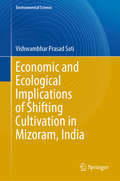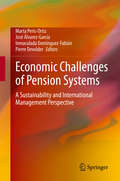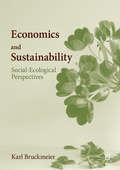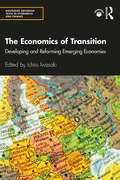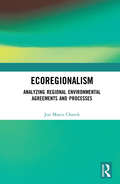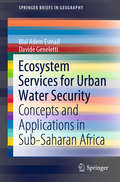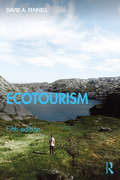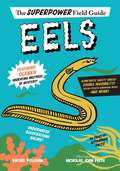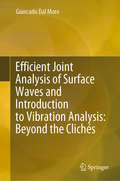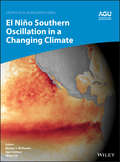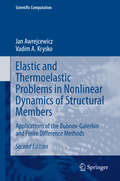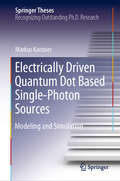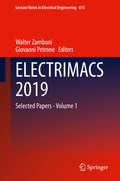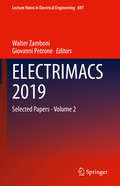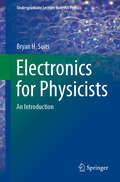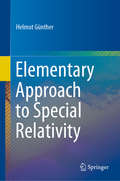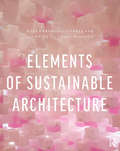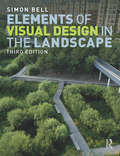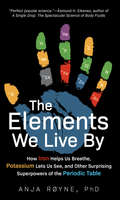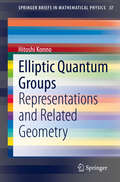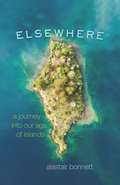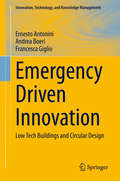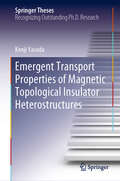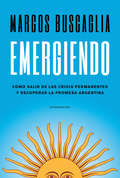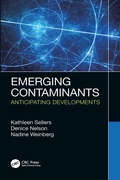- Table View
- List View
Economic and Ecological Implications of Shifting Cultivation in Mizoram, India (Environmental Science and Engineering)
by Vishwambhar Prasad SatiThis book presents the first empirically tested, comprehensive study on shifting cultivation in Mizoram. Shifting cultivation is a unique and centuries-old practice carried out by the people of Mizoram in Northeast India. Today, it is a non-economic activity as it does not produce sufficient crops, and as a result, the area under shifting cultivation is decreasing. Such cultivation leads to the burning and degradation of vast areas of forestland and therefore has adverse impacts on the floral and faunal resources. This book is a valuable resource for government workers, policymakers, academics, farmers and those who are directly or indirectly associated with practical farming, or with framing and implementing policies. It is equally important to master’s and Ph.D. students of geography, resource management, development, and environmental studies who are involved in research and development.
Economic Challenges of Pension Systems: A Sustainability and International Management Perspective
by Pierre Devolder Marta Peris-Ortiz José Álvarez-García Inmaculada Domínguez-FabiánThis book examines the major economic challenges associated with the sustainability of public pensions, specifically demographic change, labor-market relations, and risk sharing. The issue of public pensions occupies the political and economic agendas of many major governments in the world. International organizations such as the World Bank and the OECD warn that the economic changes driven by an aging society negatively affects the sustainability of pension systems. This book analyzes different global public pension systems to offer policies, methods and tools for sustainable public pensions. Real case studies from France, Sweden, Latin America, Algeria, USA and Mexico are featured.
Economics and Sustainability: Social-Ecological Perspectives
by Karl BruckmeierThis textbook provides an overview of economic perspectives on sustainability. It synthesises economic, ecological and interdisciplinary sustainability research and by applying an integrated social-ecological and economic framework, demonstrates how this research can be improved and implemented in practice. Split into three parts, the book begins by introducing a range of topics forming the basis of knowledge needed to understand the varying sustainability discourses in economics, ecology and interdisciplinary sustainability research. Chapters cover the political context of sustainability; the history of sustainability in European environmental discourses dating back to the seventeenth century; as well as various problems and forms of interdisciplinary knowledge integration and synthesis in the sustainability process. Part II reviews the core economic themes relevant to sustainable development including natural resource management, environmental economics and ecological economics. Also highlighted are often neglected issues such as conflicts, disasters and interrelated crises on the way towards sustainability. The chapters in Part III discuss the future of the sustainability process. They argue for the necessity of overhauling the relationship between science and practice; explore failures and the unforeseen difficulties of sustainability transformation; and discuss how to enable a long term sustainability process that reaches into the distant future.An innovative resource for a broad range of interdisciplinary programmes on sustainability. The book will be an invaluable reference for master and PhD students, instructors, researchers and practitioners in sustainability governance.
The Economics of Transition: Developing and Reforming Emerging Economies (Routledge Advanced Texts in Economics and Finance)
by Ichiro IwasakiIn the last three decades since the fall of the Berlin Wall, there has been a vast amount of study looking at transforming the planned economy to a market economy from both theoretical and empirical aspects. This book provides an overview and insight into transition economies in the recent decades and looks at key economics topics from the so-called “transition strategy debate” to environmental reform. The book also includes an analytical review and meta-analysis of the existing literature. By integrating theoretical discussions and synthesizing empirical findings in a systematic manner, this book may help to enlighten the debate on the timing, speed, and policy sequence of economic transition. The book will particularly appeal to researchers, policy makers, other practitioners, and under- and post-graduate students who are interested in transition economies in Eastern Europe, the former Soviet Union, Southeast Asia, and China. It aims to be read as an advanced reader.
Ecoregionalism: Analyzing Regional Environmental Agreements and Processes
by Jon Marco ChurchThis book provides a comprehensive understanding of environmental regionalism at the international level, analyzing the concept and identifying recurring patterns from six in-depth case studies. While ecoregions or environmental regions are defined on ecological boundaries rather than administrative criteria, ecoregionalism is the idea that regional dynamics should cluster around ecoregions, while ecoregionalization is the tendency of regional dynamics to cluster around ecoregions. Focusing on the international level, this book presents six cases of ecoregional processes from around the world and the regional environmental agreements: two are terrestrial, the Alps and the Andes; two are marine, the Mediterranean Sea and the Baltic Sea; two are related to freshwater ecosystems: the Amu Darya in Central Asia and the Great Lakes in North America. The book analyzes both ecoregional processes focused on the environment, as well as intersectoral ecoregional processes. The case studies are analyzed based on the ecoregional governance framework, developed by the author for this book. Despite the diversity of context, the similarity of the governance system of the six cases is striking. Several recurring patterns have been identified, which may also extend to the subnational level. They are not design principles, but may be taken into consideration for the design or redesign of current and future regional environmental agreements and processes. This book will be of great interest to students and scholars of environmental politics, natural resource management, spatial planning and international relations.
Ecosystem Services for Urban Water Security: Concepts and Applications in Sub-Saharan Africa (SpringerBriefs in Geography)
by Blal Adem Esmail Davide GenelettiThe book addresses the challenges of urban water security and adaptive management in Sub-Saharan Africa, exploring and interlinking novel concepts of ecosystems services, watershed investments, and boundary work. Specifically, the book’s goals are to (i) present a conceptual framework for the urban water sector from an ecosystem services perspective, highlighting the specificities of the Sub-Saharan context; (ii) develop an operational approach to designing and assessing the impacts of watershed investments, based on ecosystem services and boundary work; and (iii) test the approach through a case study in Asmara, Eritrea, and discuss the findings and lessons learned that can be applied in other contexts. Through a fully worked out case study, from identification of water challenges and opportunities to spatially explicit modelling, the book offers a sound and accessible, coverage of issues and proposed solutions to better operationalize ecosystem services, watershed investments and boundary work, to promote adaptive management, and achieve water security in the context of rapidly developing cities in Sub-Saharan Africa. The book is an effective tool for capacity building of diverse stakeholders on the urban water sector, including water managers, local and national policy-makers as well as a suitable resource for both undergraduate and post-graduate courses in planning and geography.
Ecotourism
by David A. FennellThe new fifth edition of Ecotourism focuses on an array of economic, social and ecological inconsistencies that continue to plague ecotourism in theory and practice, and examines the sector in reference to other related forms of tourism, impacts, conservation, sustainability, education and interpretation, policy and governance, and the ethical imperative of ecotourism as these apply to the world&’s greenest form of tourism. Building on the success of prior editions, the text has been revised throughout to incorporate recent research, including ecotourism taking place in under-represented world regions. It includes new case studies on important themes in research and practice as well as learning objectives in each chapter. David Fennell provides an authoritative and comprehensive review of the most important issues, including climate change and UN Sustainable Development Goals. Ecotourism continues to be embraced as the antithesis of mass tourism because of its promise of achieving sustainability through conservation mindedness, community development, education and learning, and the promotion of nature-based activities that are sensitive to both ecological and social systems. The book debates to what extent this promise has been realised. An essential reference for those interested in ecotourism, the book is accessible to students, but retains the depth required for use by researchers and practitioners in the field. This book will be of interest to students across a range of disciplines including geography, economics, business, ethics, biology, and environmental studies.
Eels (Superpower Field Guide)
by Rachel Poliquin Nicholas John FrithThis fourth installment in the hilarious and highly illustrated full-color Superpower Field Guide series features Olenka, an ordinary eel. Olenka may be slimy, wiggly, and the color of mud, but never, ever underestimate an eel. Meet Olenka, an ordinary eel. Did I hear you say, &“But aren&’t eels just long slippery slimy fishy-things that . . . hmm . . . . Is there anything else to know about eels?&” You bet your buttons there is! Sit back and hold on tight, because Olenka is going to amaze you with superpowers such as double invisibility and shape-shifting, and the super secret Lair of the Abyss (that means a top-secret deep-sea hideout). In fact, Olenka's life is so impossibly extraordinary, it has baffled the smartest scientists in the world for thousands of years. &“Impossible!&” you say. I say, "you don&’t know eels." But you will. Includes a ruler printed along the edge of the book&’s back cover to aid the observations of young field scientists everywhere!
Efficient Joint Analysis of Surface Waves and Introduction to Vibration Analysis: Beyond the Clichés
by Giancarlo Dal MoroThis book bridges the gap between theory and practice, showing how a detailed definition of the shear-wave velocity (VS) profile can be efficiently obtained using limited field equipment and following simple acquisition procedures. It demonstrates how surface waves (used to define the VS profile) and vibration data (used to describe the dynamic behaviour of a building) can be recorded using the same equipment, and also highlights common problems, ambiguities and pitfalls that can occur when adopting popular methodologies, which are often based on a series of simplistic assumptions. Today, most national and international building codes take into account a series of parameters aimed at defining the local seismic hazard. Sites are characterised based on the local VS profile, and the dynamic behaviour of existing buildings is defined through the analysis of their eigenmodes. The book includes a series of case studies to help readers gain a deeper understanding of seismic and vibration data and the meaning (pros and cons) of a series of techniques often referred to as MASW, ESAC, SPAC, ReMi, HVSR, MAAM and HS. It also provides access to some of the datasets so that readers can gain a deeper and more concrete understanding of both the theoretical and practical aspects.
El Niño Southern Oscillation in a Changing Climate (Geophysical Monograph Series #254)
by Michael J. McPhaden Agus Santoso Wenju CaiComprehensive and up-to-date information on Earth’s most dominant year-to-year climate variation The El Niño Southern Oscillation (ENSO) in the Pacific Ocean has major worldwide social and economic consequences through its global scale effects on atmospheric and oceanic circulation, marine and terrestrial ecosystems, and other natural systems. Ongoing climate change is projected to significantly alter ENSO’s dynamics and impacts. El Niño Southern Oscillation in a Changing Climate presents the latest theories, models, and observations, and explores the challenges of forecasting ENSO as the climate continues to change. Volume highlights include: Historical background on ENSO and its societal consequences Review of key El Niño (ENSO warm phase) and La Niña (ENSO cold phase) characteristics Mathematical description of the underlying physical processes that generate ENSO variations Conceptual framework for understanding ENSO changes on decadal and longer time scales, including the response to greenhouse gas forcing ENSO impacts on extreme ocean, weather, and climate events, including tropical cyclones, and how ENSO affects fisheries and the global carbon cycle Advances in modeling, paleo-reconstructions, and operational climate forecasting Future projections of ENSO and its impacts Factors influencing ENSO events, such as inter-basin climate interactions and volcanic eruptions The American Geophysical Union promotes discovery in Earth and space science for the benefit of humanity. Its publications disseminate scientific knowledge and provide resources for researchers, students, and professionals.
Elastic and Thermoelastic Problems in Nonlinear Dynamics of Structural Members: Applications of the Bubnov-Galerkin and Finite Difference Methods (Scientific Computation)
by Jan Awrejcewicz Vadim A. KryskoFrom the reviews: "A unique feature of this book is the nice blend of engineering vividness and mathematical rigour. [...] The authors are to be congratulated for their valuable contribution to the literature in the area of theoretical thermoelasticity and vibration of plates." Journal of Sound and Vibration
Electrically Driven Quantum Dot Based Single-Photon Sources: Modeling and Simulation (Springer Theses)
by Markus KantnerSemiconductor quantum optics is on the verge of moving from the lab to real world applications. When stepping from basic research to new technologies, device engineers will need new simulation tools for the design and optimization of quantum light sources, which combine classical device physics with cavity quantum electrodynamics. This thesis aims to provide a holistic description of single-photon emitting diodes by bridging the gap between microscopic and macroscopic modeling approaches. The central result is a novel hybrid quantum-classical model system that self-consistently couples semi-classical carrier transport theory with open quantum many-body systems. This allows for a comprehensive description of quantum light emitting diodes on multiple scales: It enables the calculation of the quantum optical figures of merit together with the simulation of the spatially resolved current flow in complex, multi-dimensional semiconductor device geometries out of one box. The hybrid system is shown to be consistent with fundamental laws of (non-)equilibrium thermodynamics and is demonstrated by numerical simulations of realistic devices.
ELECTRIMACS 2019: Selected Papers - Volume 1 (Lecture Notes in Electrical Engineering #604)
by Giovanni Petrone Walter ZamboniThis book collects a selection of papers presented at ELECTRIMACS 2019, the 13th international conference of the IMACS TC1 Committee, held in Salerno, Italy, on 21st-23rd May 2019. The conference papers deal with modelling, simulation, analysis, control, power management, design optimization, identification and diagnostics in electrical power engineering. The main application fields include electric machines and electromagnetic devices, power electronics, transportation systems, smart grids, electric and hybrid vehicles, renewable energy systems, energy storage, batteries, supercapacitors and fuel cells, and wireless power transfer. The contributions included in Volume 1 are particularly focused on electrical engineering simulation aspects and innovative applications.
ELECTRIMACS 2019: Selected Papers - Volume 2 (Lecture Notes in Electrical Engineering #697)
by Walter Zamboni Giovanni PetroneThis book collects a selection of papers presented at ELECTRIMACS 2019 - The 13th international conference of the IMACS TC1 Committee, held in Salerno, Italy, on 21st-23rd May 2019. The conference papers deal with modelling, simulation, analysis, control, power management, design optimization, identification and diagnostics in electrical power engineering. The main application fields include electric machines and electromagnetic devices, power electronics, transportation systems, smart grids, electric and hybrid vehicles, renewable energy systems, energy storage, batteries, supercapacitors and fuel cells, wireless power transfer. The contributions included in Volume 2 are particularly focussed on methodological aspects, modelling and applied mathematics in the field of electrical engineering.
Electronics for Physicists: An Introduction (Undergraduate Lecture Notes in Physics)
by Bryan H. SuitsThis book provides undergraduate physics majors and students of related sciences with a sound basic understanding of electronics and how it is used, principally in the physical sciences. While today few science students go on to careers that demand an ability to design and build electronic circuits, many will use and rely on electronics. As scientists, they will require an appropriate level of fundamental knowledge that enables them, for example, to understand what electronic equipment is doing, to correctly interpret the measurements obtained, and to appreciate the numerous links between electronics and how it is practiced, and other areas of science. Discussing electronics in the broader context and from the point of view of the scientist, this book is intended for students who are not planning to become electronics specialists. It has been written in a relatively informal, personal style and includes detailed examples, as well as some “outside the box” material to inspire thought and creativity. A selection of relevant exercises is included at the end of each chapter.
Elementary Approach to Special Relativity
by Helmut GüntherThis book presents an alternative representation of Einstein's Special Theory of Relativity, which makes Special Relativity much more comprehensible. Moreover, one will come across a fundamental relationship between the Special Theory of Relativity and the mechanics of space lattice. In all previous formulations, the Einsteinian special principle of relativity, in one or the other form is used as the starting point for Special Relativity. In correspondence to this principle, one takes it as granted apriori, that all observers independent of their uniform motion to each other measure one and the same propagation velocity of a light signal. This book is thought of as a lecture for physicists, mathematicians and computer scientists and concentrates on the students of these fields. The book should reach a broad circle of interested readers from the fields of natural sciences and philosophy and provide and invigorating experience for engineers.
Elements of Sustainable Architecture
by Rosa Urbano Gutiérrez Laura de la Plaza HidalgoFor sustainable architecture to become a reality, the way we design buildings needs to change. Many architects are concerned that sustainable technologies may interfere with a building’s aesthetic appearance, and so these are often ‘added on’ once the design process is complete. Elements of Sustainable Architecture solves this dilemma by helping students to develop the design skills they need to create sustainable buildings – ensuring that ecological considerations are applied throughout the design process. Restoring the primacy of aesthetics and creativity to sustainable design, the book focuses on strategies that have the greatest impact on building design. It also shows the influence of sustainability considerations on choices about aspects such as composition, form, space, tectonics, materials, colour, textures, proportion and position. Specifically designed to offer a new way of understanding architecture, the book: introduces students to the basic principles and methods of sustainable design; features current examples and inspiring case studies to support learning step by step; presents information in a visually appealing, intuitive, easy-to-understand way; includes over 500 high-quality colour diagrams, drawings, sketches and photographs. A clear, visual introduction to creating aesthetically beautiful and sustainable buildings, this is essential reading for students in sustainable architecture courses.
Elements of Visual Design in the Landscape
by Simon BellWhat makes a visually appealing landscape? How can the design and use of a landscape be harmonized? In this significantly revised and updated third edition of Simon Bell's seminal text, he further explores the answers to these questions by interrogating a range of design principles, applications and ideas. Written for students, instructors and professionals, the book unveils a visual design vocabulary for anyone involved with landscape aesthetics including landscape architects, architects, planners, urban designers, landscape managers, foresters, geographers and ecologists. Structured around key design terms, which are explained and illustrated using an extensive range of examples from around the world, including North America, Europe and Asia, this book enables you to describe, debate and design the visual landscape. It starts with basic elements, before moving onto variable design components, and then the ways these elements are organized into compositions, in order to demonstrate how landscapes are created and how meanings and patterns are perceived within them. This new full colour edition contains over 240 images; an updated introduction; examples from China, Vietnam and central Asia; a chapter on how to read and understand visual design elements in the landscape; a teaching model for instructors; and expanded appendix materials including a glossary, references and further reading.
The Elements We Live By: How Iron Helps Us Breathe, Potassium Lets Us See, and Other Surprising Superpowers of the Periodic Table
by Anja RøyneThe periodic table as you&’ve never seen it before—starring the elements that power our bodies and our way of life Some elements get all the attention: glittering gold, radioactive uranium—materials we call &“precious&” because they are so rare. But what could be more precious than the building blocks of life—from the oxygen in our air to the carbon in all living things? In The Elements We Live By, physicist and award-winning author Anja Røyne reminds us that we&’d be lost without the quiet heroes of the periodic table. Our bodies need phosphorous to hold our DNA together, potassium to power our optic nerves, and many more elements—in just the right amounts—to function. Other fundamental elements keep our technology (and society) running: Our phones contain arsenic, boron, and gallium to control signals and store information; indium and tin for the touch screen; and lithium for the battery. Everything is made of elements—every galaxy, star, and planet—from the iron in Earth&’s core to the silicon in its sand. But that doesn&’t mean the elements we rely on will never run out; for example, about half of the lithium we need is extracted from rocks in Australia, and the other half is from saltwater in Argentina and Chile. As Røyne travels the world to find where these elements exist (some in ever-shrinking amounts), she shows how vitally urgent it is for us to protect them—the elements of our very existence.
Elliptic Quantum Groups: Representations and Related Geometry (SpringerBriefs in Mathematical Physics #37)
by Hitoshi KonnoThis is the first book on elliptic quantum groups, i.e., quantum groups associated to elliptic solutions of the Yang-Baxter equation. Based on research by the author and his collaborators, the book presents a comprehensive survey on the subject including a brief history of formulations and applications, a detailed formulation of the elliptic quantum group in the Drinfeld realization, explicit construction of both finite and infinite-dimensional representations, and a construction of the vertex operators as intertwining operators of these representations. The vertex operators are important objects in representation theory of quantum groups. In this book, they are used to derive the elliptic q-KZ equations and their elliptic hypergeometric integral solutions. In particular, the so-called elliptic weight functions appear in such solutions. The author’s recent study showed that these elliptic weight functions are identified with Okounkov’s elliptic stable envelopes for certain equivariant elliptic cohomology and play an important role to construct geometric representations of elliptic quantum groups. Okounkov’s geometric approach to quantum integrable systems is a rapidly growing topic in mathematical physics related to the Bethe ansatz, the Alday-Gaiotto-Tachikawa correspondence between 4D SUSY gauge theories and the CFT’s, and the Nekrasov-Shatashvili correspondences between quantum integrable systems and quantum cohomology. To invite the reader to such topics is one of the aims of this book.
Elsewhere: A Journey into Our Age of Islands
by Alastair BonnettThere are millions of islands on our planet. New islands are being built at an unprecedented rate, for tourism and territorial ambition. Many are also disappearing, besieged by rising sea levels. The story of our world’s islands is one of the great dramas of our time, and it is playing out around the planet—islands are sprouting or being submerged everywhere from the South China Sea to the Atlantic. Elsewhere is the story of this strange and mesmerizing planetary spectacle. In this book, explorer and geographer Alastair Bonnett takes us on a thought-provoking tour of the world’s most fascinating islands. He traveled the globe to provide a firsthand look at numerous islands, sketching a vivid likeness of each one he visited. From a “crannog,” an ancient artificial island in a Scottish loch, to the militarized artificial islands China is building; from the disappearing islands that remain the home of native Central Americans to the ritzy new islands of Dubai; from Hong Kong to the Isles of Scilly—all have compelling stories to tell. As we journey around the world with Bonnett, he addresses urgent contemporary issues such as climate change, economic inequality and the changing balance of world power as reflected in the fates of islands. Along the way, we also learn about the many ways islands rise and fall, the long and little-known history of human island building and the prospect that the inland hills and valleys will one day be archipelagos. Featuring Bonnett’s charming hand-drawn maps and 33 full-color photos, Elsewhere is a captivating travel book for any armchair adventurer.
Emergency Driven Innovation: Low Tech Buildings and Circular Design (Innovation, Technology, and Knowledge Management)
by Ernesto Antonini Andrea Boeri Francesca GiglioThis book explores the relationship between the circular economy and the building technologies within the quintuple helix innovation model. The main question the book answers is whether and how the conversion of sustainable construction processes can be a powerful engine of innovation for the industry. The post-disaster settlements and temporary shelters are assumed as examples of what can be defined as circular buildings in regards to the technical arrangements and features, material and process reversibility, as the social and participative dimensions.Several cases of these interventions are documented and classified by three thematic axes: design, building and living. This highlighted new trajectories for innovation in building technology, consistent with the social, economic and productive dynamics that no longer allows for growing performance by increasing the resource demand. A theoretic framework is traced supporting this vision, which shows how the low technologies can respond to the transition of the economic model from linear to circular. Within this trajectory, the low-tech design for remanufacturing represents a reference framework and a promising tool applicable to the building processes.The enabling technologies and new paradigms for the transition to circular economy emerging from the European research scenario are also mapped, outlining z`the possible future developments in line with open technical and societal challenges.
Emergent Transport Properties of Magnetic Topological Insulator Heterostructures (Springer Theses)
by Kenji YasudaThis book reveals unique transport phenomena and functionalities in topological insulators coupled with magnetism and superconductivity. Topological insulators are a recently discovered class of materials that possess a spin-momentum-locked surface state. Their exotic spin texture makes them an exciting platform for investigating emergent phenomena, especially when coupled with magnetism or superconductivity. Focusing on the strong correlation between electricity and magnetism in magnetic topological insulators, the author presents original findings on current-direction-dependent nonreciprocal resistance, current-induced magnetization reversal and chiral edge conduction at the domain wall. In addition, he demonstrates how the coupling between superconductivity and topological surface state leads to substantial nonreciprocal resistance. The author also elucidates the origins of these phenomena and deepens readers’ understanding of the topologically nontrivial electronic state. The book includes several works which are published in top journals and were selected for the President’s Award by the University of Tokyo and for the Ikushi Prize, awarded to distinguished Ph.D. students in Japan.
Emergiendo: Cómo salir de las crisis permanentes y recuperar la promesa argentina
by Marcos BuscagliaMarcos Buscaglia analiza en detalle la peor crisis de la historia argentina (2018-2020) y propone un conjunto articulado y sólido de reformas para que el país encuentre su rumbo y comience a emerger del subdesarrollo dando lugar a una nueva república, superadora de la conservadora y de la peronista. La Argentina atraviesa el peor momento de su historia al tiempo que los argentinos, que parecemos capaces de naturalizarlo todo, sin objetivos ni aspiraciones comunes, empezamos a desdibujar nuestra identidad como sociedad. Marcos Buscaglia describe aquí, con detalle y profundidad inéditos, la crisis 2018-2020, pero va mucho más allá: presenta una visión, un camino para empezar a emerger. La salida tiene que ver con la economía y con la política, claro, pero también con la ciudadanía y la cultura porque, en última instancia, de lo que se trata es de valores. Poco piadoso y preciso en el reconocimiento de nuestras inconsistencias, valiente y sólido en el enunciado de las reformas necesarias, entusiasta y esperanzado en el potencial argentino, este libro propone la construcción de una nueva república, superadora tanto de la conservadora como de la peronista. El mensaje es claro: con vocación de futuro y voluntad de éxito, si los argentinos nos ponemos de acuerdo sobre el rumbo, no habrá obstáculo difícil de sortear. Porque no podemos permitir que nos gane el caos, conforme empecemos a andar, iremos dejando en el pasado nuestra historia de desencuentro y fracaso recurrentes. Entonces sí, finalmente, estaremos emergiendo.
Emerging Contaminants: Anticipating Developments
by Kathleen Sellers Denice K. Nelson Nadine WeinbergEmerging Contaminants: Anticipating Developments examines the factors that have led "new" environmental contaminants to emerge in the past and combines the lessons learned to anticipate potential new developments. The analyses described in this book originate in multiple disciplines: the science of toxicology; environmental law and regulation; the field of product stewardship; and the social science which explains why ideas take hold. Over a dozen case studies of contaminants that emerged as environmental issues over the last hundred years illustrate crucial points. The results of the analyses in this book support a step-by-step method to assess the potential for a contaminant to emerge, and a framework to apply those conclusions to managing site liabilities. Features: Describes an unprecedented understanding of why contaminants emerge as issues, based on a multidisciplinary analysis Makes abstract concepts tangible, basing analyses on data and illustrating key points with case studies Enables readers to anticipate and prepare to manage future challenges associated with emerging chemicals Presents an analytical framework for companies to assess and manage business risks Written for regulators, policymakers, industry professionals with responsibility for contaminated site management, as well as attorneys, and consultants, this book provides a framework for anticipating the emergence of new contaminants so that the risks–whether to human health and the environment or to a business–can be anticipated and appropriately managed.
